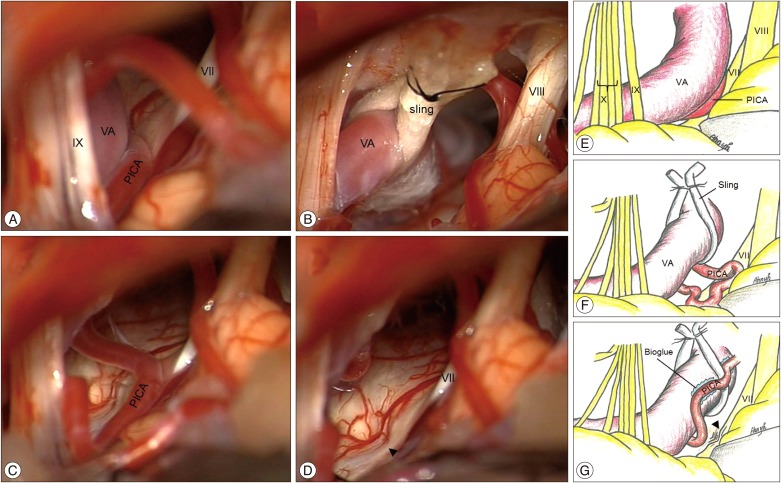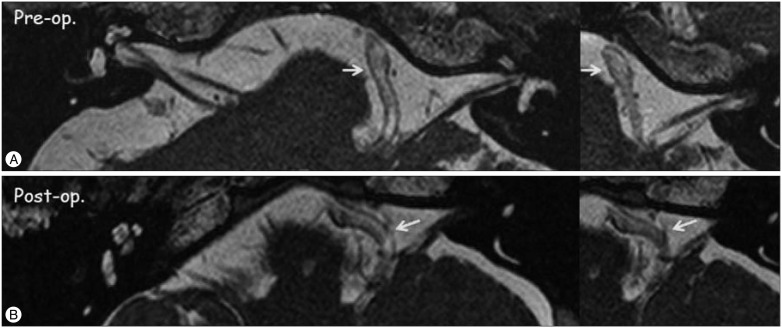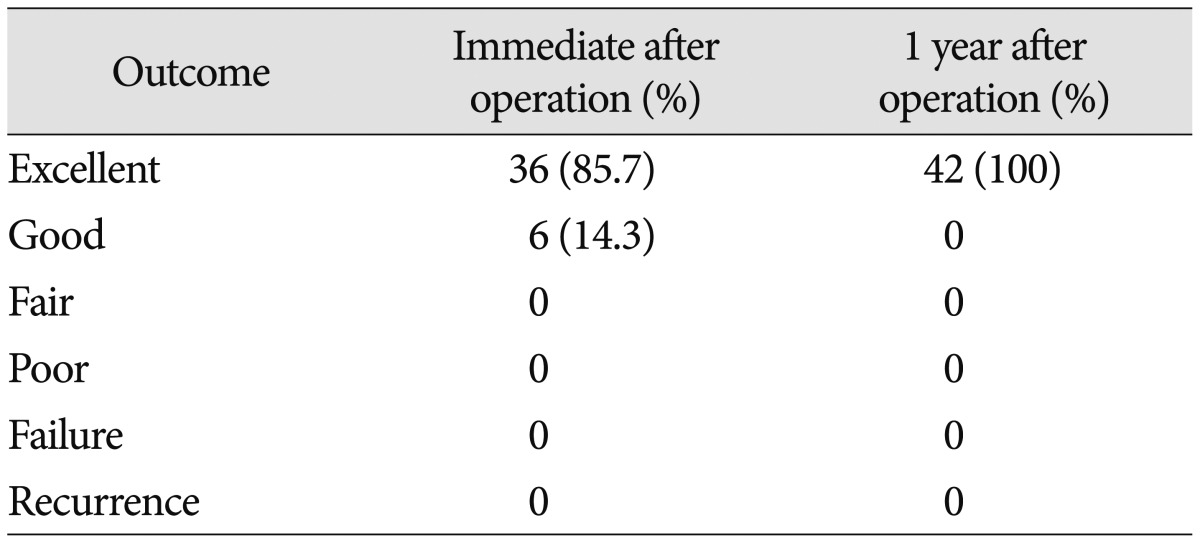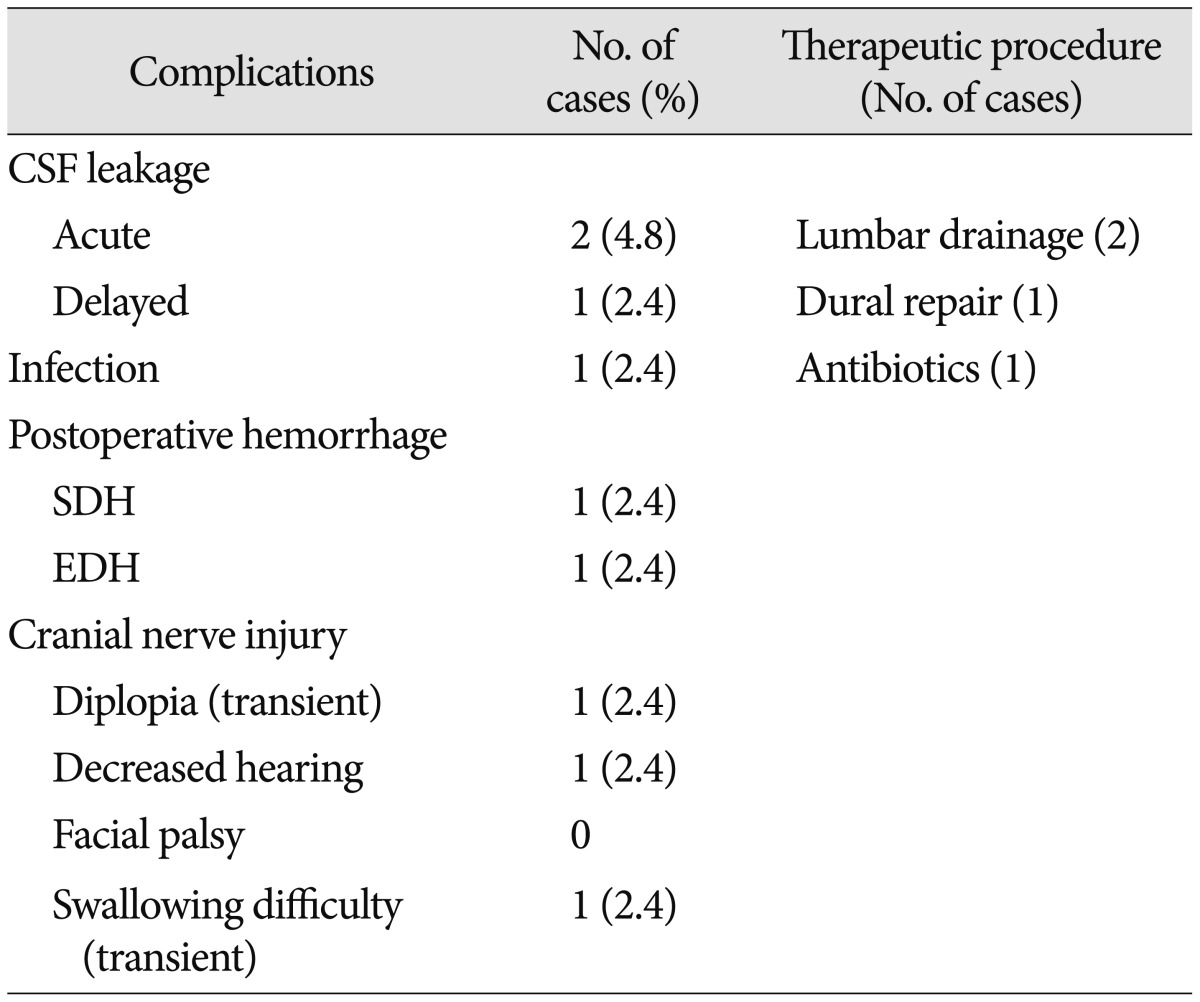1. Attabib N, Kaufmann AM. Use of fenestrated aneurysm clips in microvascular decompression surgery. Technical note and case series. J Neurosurg. 2007; 106:929–931. PMID:
17542544.

2. Barker FG 2nd, Jannetta PJ, Bissonette DJ, Shields PT, Larkins MV, Jho HD. Microvascular decompression for hemifacial spasm. J Neurosurg. 1995; 82:201–210. PMID:
7815147.

3. Bejjani GK, Sekhar LN. Repositioning of the vertebral artery as treatment for neurovascular compression syndromes. Technical note. J Neurosurg. 1997; 86:728–732. PMID:
9120641.

4. Campos-Benitez M, Kaufmann AM. Neurovascular compression findings in hemifacial spasm. J Neurosurg. 2008; 109:416–420. PMID:
18759570.

5. Choi MS, Kim YI, Ahn YH. Lipoma causing glossopharyngeal neuralgia : a case report and review of literature. J Korean Neurosurg Soc. 2014; 56:149–151. PMID:
25328654.

6. Chung SS, Chang JH, Choi JY, Chang JW, Park YG. Microvascular decompression for hemifacial spasm : a long-term follow-up of 1,169 consecutive cases. Stereotact Funct Neurosurg. 2001; 77:190–193. PMID:
12428639.

7. Chung SS, Chang JW, Kim SH, Chang JH, Park YG, Kim DI. Microvascular decompression of the facial nerve for the treatment of hemifacial spasm : preoperative magnetic resonance imaging related to clinical outcomes. Acta Neurochir (Wien). 2000; 142:901–906. discussion 907. PMID:
11086829.
8. Dannenbaum M, Lega BC, Suki D, Harper RL, Yoshor D. Microvascular decompression for hemifacial spasm : long-term results from 114 operations performed without neurophysiological monitoring. J Neurosurg. 2008; 109:410–415. PMID:
18759569.

9. Ehni G, Woltman HW. Hemifacial spasm : review of one hundred and six cases. Arch NeurPsych. 1945; 53:205–211.
10. Ferreira M, Walcott BP, Nahed BV, Sekhar LN. Vertebral artery pexy for microvascular decompression of the facial nerve in the treatment of hemifacial spasm. J Neurosurg. 2011; 114:1800–1804. PMID:
21275561.

11. Huh R, Han IB, Moon JY, Chang JW, Chung SS. Microvascular decompression for hemifacial spasm : analyses of operative complications in 1582 consecutive patients. Surg Neurol. 2008; 69:153–157. PMID:
18261641.

12. Hyun SJ, Kong DS, Park K. Microvascular decompression for treating hemifacial spasm : lessons learned from a prospective study of 1,174 operations. Neurosurg Rev. 2010; 33:325–334. PMID:
20349099.

13. Ichikawa T, Agari T, Kurozumi K, Maruo T, Satoh T, Date I. "Double-stick tape" technique for transposition of an offending vessel in microvascular decompression : technical case report. Neurosurgery. 2011; 68(2 Suppl Operative):377–382. discussion 382. PMID:
21389896.
14. Illingworth RD, Porter DG, Jakubowski J. Hemifacial spasm : a prospective long-term follow up of 83 cases treated by microvascular decompression at two neurosurgical centres in the United Kingdom. J Neurol Neurosurg Psychiatry. 1996; 60:72–77. PMID:
8558156.

15. Jannetta PJ, Abbasy M, Maroon JC, Ramos FM, Albin MS. Etiology and definitive microsurgical treatment of hemifacial spasm. Operative techniques and results in 47 patients. J Neurosurg. 1977; 47:321–328. PMID:
894338.
16. Jo KW, Kong DS, Park K. Microvascular decompression for hemifacial spasm : long-term outcome and prognostic factors, with emphasis on delayed cure. Neurosurg Rev. 2013; 36:297–301. PMID:
22940822.

17. Kang JH, Kang DW, Chung SS, Chang JW. The effect of microvascular decompression for hemifacial spasm caused by vertebrobasilar dolichoectasia. J Korean Neurosurg Soc. 2012; 52:85–91. PMID:
23091664.

18. Khoo HM, Yoshimine T, Taki T. A "sling swing transposition" technique with pedicled dural flap for microvascular decompression in hemifacial spasm. Neurosurgery. 2012; 71(1 Suppl Operative):25–30. discussion 30-31. PMID:
22186845.

19. Kim JP, Park BJ, Choi SK, Rhee BA, Lim YJ. Microvascular decompression for hemifacial spasm associated with vertebrobasilar artery. J Korean Neurosurg Soc. 2008; 44:131–135. PMID:
19096662.

20. Kondo A. Follow-up results of microvascular decompression in trigeminal neuralgia and hemifacial spasm. Neurosurgery. 1997; 40:46–51. discussion 51-52. PMID:
8971823.

21. Kurokawa Y, Maeda Y, Toyooka T, Inaba K. Microvascular decompression for hemifacial spasm caused by the vertebral artery : a simple and effective transposition method using surgical glue. Surg Neurol. 2004; 61:398–403. PMID:
15031085.

22. Kwon HM, Lee YS. Dolichoectasia of the intracranial arteries. Curr Treat Options Cardiovasc Med. 2011; 13:261–267. PMID:
21404000.

23. Kyoshima K, Watanabe A, Toba Y, Nitta J, Muraoka S, Kobayashi S. Anchoring method for hemifacial spasm associated with vertebral artery : technical note. Neurosurgery. 1999; 45:1487–1491. PMID:
10598720.

24. Laws ER Jr, Kelly PJ, Sundt TM Jr. Clip-grafts in microvascular decompression of the posterior fossa. Technical note. J Neurosurg. 1986; 64:679–681. PMID:
3950754.
25. Lee MH, Lee HS, Jee TK, Jo KI, Kong DS, Lee JA, et al. Cerebellar retraction and hearing loss after microvascular decompression for hemifacial spasm. Acta Neurochir (Wien). 2015; 157:337–343. PMID:
25514867.

26. Marneffe V, Polo G, Fischer C, Sindou M. [Microsurgical vascular decompression for hemifacial spasm. Follow-up over one year, clinical results and prognostic factors. Study of a series of 100 cases]. Neurochirurgie. 2003; 49:527–535. PMID:
14646818.
27. Masuoka J, Matsushima T, Kawashima M, Nakahara Y, Funaki T, Mineta T. Stitched sling retraction technique for microvascular decompression : procedures and techniques based on an anatomical viewpoint. Neurosurg Rev. 2011; 34:373–379. discussion 379-380. PMID:
21347661.

28. McLaughlin MR, Jannetta PJ, Clyde BL, Subach BR, Comey CH, Resnick DK. Microvascular decompression of cranial nerves : lessons learned after 4400 operations. J Neurosurg. 1999; 90:1–8. PMID:
10413149.

29. Montaner J, Alvarez-Sabín J, Rovira A, Molina C, Grivé E, Codina A, et al. [Vertebrobasilar abnormalities in patients with hemifacial spasm : MR-angiography findings]. Rev Neurol. 1999; 29:700–703. PMID:
10560103.
30. Park JS, Kong DS, Lee JA, Park K. [Hemifacial spasm : neurovascular compressive patterns and surgical significance]. Acta Neurochir (Wien). 2008; 150:235–241. discussion 241. PMID:
18297233.

31. Park KD, Kim YI, Ahn YH. Cerebello-pontine angle lipoma causing hemifacial spasm. J Korean Soc Stereotact Funct Neurosurg. 2014; 10:37–40.
32. Payner TD, Tew JM Jr. Recurrence of hemifacial spasm after microvascular decompression. Neurosurgery. 1996; 38:686–690. discussion 690-691. PMID:
8692385.

33. Rawlinson JN, Coakham HB. The treatment of hemifacial spasm by sling retraction. Br J Neurosurg. 1988; 2:173–178. PMID:
3267301.

34. Samii M, Günther T, Iaconetta G, Muehling M, Vorkapic P, Samii A. Microvascular decompression to treat hemifacial spasm : long-term results for a consecutive series of 143 patients. Neurosurgery. 2002; 50:712–718. discussion 718-719. PMID:
11904020.
35. Shigeno T, Kumai J, Endo M, Oya S, Hotta S. Snare technique of vascular transposition for microvascular decompression--technical note. Neurol Med Chir (Tokyo). 2002; 42:184–189. discussion 190. PMID:
12013673.
36. Shimano H, Kondo A, Yasuda S, Inoue H, Park YT, Murao K. Microvascular decompression for hemifacial spasm associated with bilateral vertebral artery compression. World Neurosurg. 2015; 84:1178.e0005–1178.e0009. PMID:
26102619.

37. Sindou M, Leston JM, Decullier E, Chapuis F. Microvascular decompression for trigeminal neuralgia : the importance of a noncompressive technique--Kaplan-Meier analysis in a consecutive series of 330 patients. Neurosurgery. 2008; 63(4 Suppl 2):341–350. discussion 350-351. PMID:
18981841.
38. Thirumala P, Frederickson AM, Balzer J, Crammond D, Habeych ME, Chang YF, et al. Reduction in high-frequency hearing loss following technical modifications to microvascular decompression for hemifacial spasm. J Neurosurg. 2015; 123:1059–1064. PMID:
26162037.

39. Tomasello F, Alafaci C, Salpietro FM, Longo M. Bulbar compression by an ectatic vertebral artery : a novel neurovascular construct relieved by microsurgical decompression. Neurosurgery. 2005; 56(1 Suppl):117–124. discussion 117-124. PMID:
15799799.
40. Yuan Y, Wang Y, Zhang SX, Zhang L, Li R, Guo J. Microvascular decompression in patients with hemifacial spasm : report of 1200 cases. Chin Med J (Engl). 2005; 118:833–836. PMID:
15989764.
41. Zaidi HA, Awad AW, Chowdhry SA, Fusco D, Nakaji P, Spetzler RF. Microvascular decompression for hemifacial spasm secondary to vertebrobasilar dolichoectasia : surgical strategies, technical nuances and clinical outcomes. J Clin Neurosci. 2015; 22:62–68. PMID:
25510536.







 PDF
PDF ePub
ePub Citation
Citation Print
Print






 XML Download
XML Download